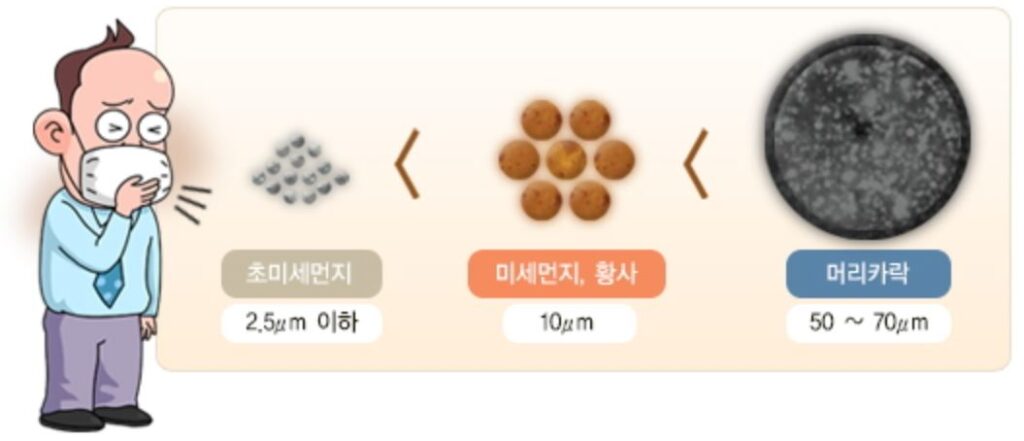Springtime Agony — The Battle with Allergic Rhinitis

_
Those who’ve suffered from it know how tormenting it can be — allergic rhinitis.
This chronic condition occurs when allergens irritate the nasal mucosa, and unfortunately, there is still no complete cure.
What’s more alarming is that despite remarkable advances in modern medicine, the number of allergic rhinitis patients continues to increase.
_
The main culprits are said to be environmental pollution and weakened immunity.
In spring, when symptoms often worsen, sufferers must clearly understand the causes and take steps to prevent flare-ups during this vulnerable season.
_
_
Beware of “Deadly Dust” — Fine Particulate Matter
_
For those with severe rhinitis, the arrival of spring can feel dreadful.
Seasonal allergies come back unfailingly — nasal congestion, endless runny nose, and the need to go through an entire box of tissues in a day.
Beyond the discomfort, many worry about how unhygienic they may appear to others, and mouth breathing often leads to sore throats.
_
One out of every three Koreans suffers from allergic rhinitis.
It’s one of the most common conditions around us.
Hospitals are especially crowded in March and April (spring) and again in September and October (autumn), when the temperature swings more than 10°C between day and night.
These rapid changes disrupt the body’s rhythm, causing immune overreactions — allergic (hypersensitive) responses that trigger symptoms.
_
The biggest causes? Spring pollen and the yellow dust that blows in from China.
The amount of pollen in the air depends heavily on climate conditions — dry, windy days increase pollen levels, while rain dramatically reduces them.
Naturally, symptoms fluctuate accordingly.
_
_

_
According to statistics, the number of yellow dust occurrences per year has decreased.
However, major cities in northeastern China — such as Beijing and Harbin — often record fine dust levels (particles smaller than 10 μm) up to 40 times higher than the World Health Organization’s (WHO) recommended limit of 25 μg/m².
_
What deserves even more caution is ultrafine dust, often called “deadly dust.”
These particles are smaller than 2.5 μm — just 1/100 the thickness of a human hair — and far smaller than typical fine dust (10 μm).
Unlike larger particles, ultrafine dust isn’t filtered by the nose or airways and can penetrate deeply into the lungs and bloodstream, reaching vital organs like the heart and lungs.
_
This can lead to serious illnesses such as angina or myocardial infarction.
Ultrafine particles contain large amounts of ionic substances like sulfates and nitrates (about 55%), which can worsen inflammation such as pneumonia and bronchitis.
Because they’re smaller than skin pores, they may also aggravate skin diseases.
_
_
Various Causes Behind Allergic Rhinitis
An allergic reaction generally occurs when an antibody in the blood (IgE) reacts to a specific antigen, producing chemicals like histamine inside the body.
Ordinary people don’t experience this overreaction, but experts say that allergic traits can be inherited — if parents have allergies, their children are far more likely to develop the same condition.
In short, family history plays a major role.
__
Another factor is vitamin D deficiency.
In a study of 8,000 adults, those with low vitamin D levels (“deficient group”) were twice as likely to have allergic rhinitis as those with normal levels.
Vitamin D helps suppress excessive immune reactions, so when it’s lacking, the immune system becomes overactive.
More than half of Koreans are deficient in vitamin D, yet experts say just 20 minutes of sunlight a day can generate enough of it naturally through the skin.
_

Wear a Yellow Dust Mask Outdoors and Ventilate at Noon
_
On days when yellow dust levels are high, it’s best to stay indoors altogether.
The goal is to minimize exposure to fine dust.
Keep windows tightly closed, and if you must ventilate, do so around noon — when air movement is strongest and dust concentration is lowest.
_
If you must go outside, wear a certified “yellow dust mask” approved by the Ministry of Food and Drug Safety.
When you return, wash your face, mouth, and nose thoroughly with water to remove any dust or pollutants.
_
Avoid wearing contact lenses on dusty days.
Dust and pollutants sticking to lenses can irritate the eyes and cause inflammation.
If you suffer from dry eyes, apply artificial tears regularly to relieve discomfort.
Experts advise allergic rhinitis patients to drink plenty of water to keep the throat, bronchial tubes, and nasal passages moist and to maintain a stable body temperature.
If neglected, allergic rhinitis may lead to flu, asthma, or other respiratory illnesses.
_
_
Many people mistake rhinitis as a temporary allergy that will fade over time — but ignoring it can make things worse.
Once an allergen triggers a reaction, continued exposure can cause chronic inflammation.
_
If your symptoms worsen after walking outside on a dusty day — persistent coughing lasting more than a week or chest tightness — visit an ENT specialist promptly.
Antihistamines that suppress excessive immune reactions in the nasal mucosa, blood vessels, and sensory nerves can greatly relieve symptoms.
With consistent care, may you enjoy a refreshing spring — with clear breathing and a healthy nose!

